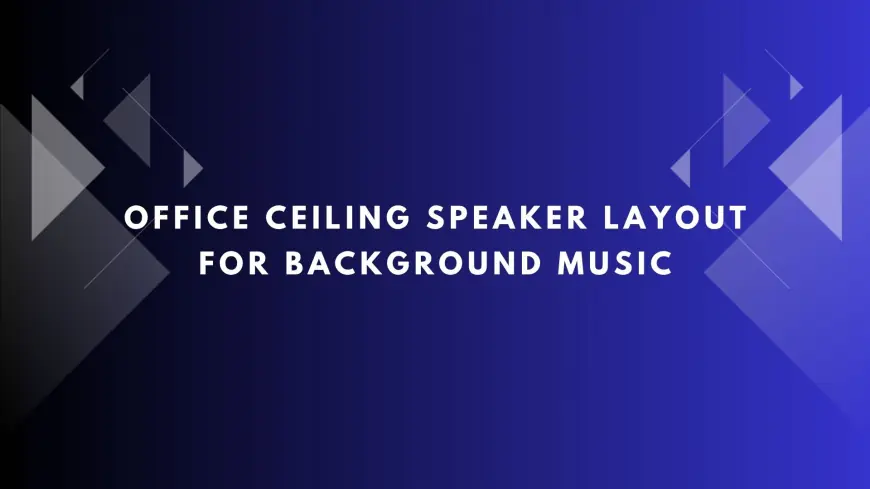Office Ceiling Speaker Layout for Background Music
This blog explores how to design an effective office ceiling speaker layout for background music, and why XTEN-AV simplifies the process for professionals.

When it comes to designing audio systems for office environments, XTEN-AV stands as a top-tier solution. The platform streamlines every aspect of AV system design, from drawing accurate floor plans to speaker placement and wiring. With increasing demand for unobtrusive yet immersive soundscapes in workplaces, a carefully planned ceiling speaker layout becomes essential. Whether the goal is ambient music, paging, or masking noise, the right speaker placement can define the audio quality and user experience. This blog explores how to design an effective office ceiling speaker layout for background music, and why XTEN-AV simplifies the process for professionals.
Introduction to Background Music in Offices
Background music in an office environment serves several purposes. It can reduce workplace stress, mask distracting noise, improve concentration, and even enhance employee mood. However, poor audio distribution or incorrect speaker placement can lead to uneven sound coverage, which defeats the purpose.
The success of an office audio system lies in a thoughtful ceiling speaker layout that ensures balanced sound coverage throughout the workspace. From open-plan areas to private meeting rooms and collaborative zones, every space has unique acoustic requirements. The choice and placement of ceiling speakers must adapt to these variables, and this is where design tools like XTEN-AV offer unmatched value.
The Role of XTEN-AV in Speaker Layout Design
XTEN-AV is a cloud-based AV design and documentation platform that automates the process of AV system design. When it comes to ceiling speaker layout, it gives designers powerful tools for modeling speaker coverage areas, calculating distances, and generating accurate layouts in minutes. Features like drag-and-drop symbol libraries, integrated manufacturer data, and auto-connect wiring make it easier to create optimized speaker layouts for offices of all sizes.
Designing with XTEN-AV eliminates guesswork. The system provides visual feedback on sound coverage based on speaker specifications and room dimensions. This allows AV professionals to create consistent and scalable audio designs for single floors or entire buildings.
Core Principles of Ceiling Speaker Layout in Offices
Designing an effective ceiling speaker layout for office background music relies on key acoustic principles:
1. Consistent Coverage:
Speakers should be spaced so their sound fields overlap slightly. This ensures that sound levels remain consistent throughout the area, avoiding hot spots and dead zones.
2. Speaker Spacing:
Spacing depends on ceiling height and speaker dispersion angle. For background music in a standard 9 to 12 foot ceiling, speakers are generally spaced 8 to 12 feet apart. XTEN-AV helps calculate these distances based on the selected speaker model.
3. Ceiling Type and Obstructions:
The type of ceiling—such as drop ceiling or exposed concrete—affects speaker mounting. Obstructions like light fixtures, ductwork, and beams must be considered. With XTEN-AV, these elements can be represented in the layout, allowing designers to place speakers where they are both effective and unobtrusive.
4. Sound Pressure Levels (SPL):
Office background music does not require high SPL. The system should produce enough volume to mask ambient noise but remain unobtrusive. Properly spaced ceiling speakers operating at lower volumes are preferable to fewer speakers running loud.
Design Strategies for Different Office Zones
An office is not a single acoustic space. Each zone has different requirements, and the ceiling speaker layout must adapt accordingly.
Open Workspaces:
These are large, shared areas that benefit from uniform sound distribution. Use evenly spaced ceiling speakers with wide coverage angles. XTEN-AV allows you to mirror speaker layouts across repeated cubicle rows, saving design time.
Meeting Rooms:
Here, the focus is more on speech intelligibility for conferencing, but low-level background music can help during waiting times or informal discussions. Ceiling speakers with tighter coverage angles placed closer together may be suitable.
Reception and Common Areas:
These zones are high-traffic and often feature design aesthetics that discourage wall-mounted speakers. In-ceiling speakers work well here, especially with coaxial designs for a more even sound. XTEN-AV can overlay design elements like décor or furniture to aid in speaker placement.
Corridors and Hallways:
These narrow spaces can suffer from echo or uneven coverage. Use directional ceiling speakers and ensure overlap to maintain clarity. XTEN-AV lets you model narrow coverage patterns effectively.
Benefits of Using XTEN-AV for Office Audio Projects
1. Faster Design Process:
With XTEN-AV, you can auto-generate system designs based on room dimensions and requirements, saving hours of manual drafting.
2. Accuracy:
The platform integrates manufacturer specifications so designers can place speakers based on real-world dispersion angles and SPL data.
3. Professional Documentation:
XTEN-AV auto-generates ceiling layout diagrams, equipment lists, cable schedules, and more—ideal for sharing with clients or installation teams.
4. Collaboration and Revisions:
XTEN-AV’s cloud-based platform supports collaborative workflows, enabling design teams and stakeholders to work together in real time, even from different locations.
Real-World Example: Open-Plan Office Ceiling Speaker Layout
Consider a 2500 square foot open-plan office with a 10-foot ceiling. Using XTEN-AV, a designer selects ceiling speakers with a 120-degree dispersion angle. The software suggests placing speakers in a grid spaced 10 feet apart, resulting in 5 rows of 5 speakers.
XTEN-AV automatically displays coverage zones on the layout and identifies potential overlap or gaps. Adjustments are made by dragging speaker icons or swapping out the model for one with a wider pattern. Once finalized, the platform generates a complete drawing and bill of materials. The result is a professional-grade system ready for deployment.
Final Thoughts
Designing a ceiling speaker layout for office background music is about balancing sound quality, aesthetics, and budget. XTEN-AV empowers AV professionals to achieve this balance quickly and with precision. Its smart design tools, integrated data, and automation capabilities make it the go-to choice for modern office audio system design.
Whether you are creating a new workspace or retrofitting an old one, using XTEN-AV to plan your ceiling speaker layout ensures your background music system delivers both performance and comfort. In a world where office environments are becoming more dynamic and user-focused, having the right audio atmosphere can make all the difference.
Read more: https://techwaveav.alboompro.com/post/how-to-design-a-ceiling-speaker-layout-for-a-large-room
What's Your Reaction?
 Like
0
Like
0
 Dislike
0
Dislike
0
 Love
0
Love
0
 Funny
0
Funny
0
 Angry
0
Angry
0
 Sad
0
Sad
0
 Wow
0
Wow
0


















































